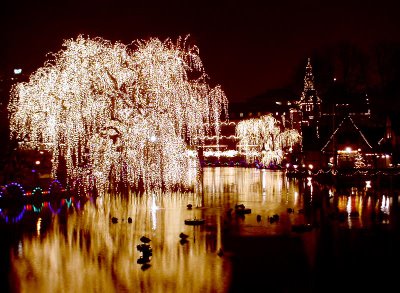Back from Copenhagen 3

It was first called "Tivoli & Vauxhall": "Tivoli" alluding to the Jardin de Tivoli in Paris (which in its turn had been named from Tivoli near Rome), and "Vauxhall" alluding to the Vauxhall Gardens in London.
Tivoli's founder, Georg Carstensen (b. 1812 - d. 1857) obtained a five-year charter to create Tivoli by telling King Christian VIII that "when the people are amusing themselves, they do not think about politics". The monarch granted Carstensen use of roughly 15 acres (61,000 m²) of the fortified glacis outside Vesterport (the West Gate) at the annual rent of 945 kroner. Therefore, until the 1850s, Tivoli was outside the city, accessible through the West Gate.
From the very start, Tivoli included a variety of attractions: buildings in the exotic style of an imaginary Orient: a theatre, band stands, restaurants and cafés, flower gardens, and mechanical amusement rides such as a merry-go-round and a primitive scenic railway. After dark, coloured lamps illuminated the gardens. On certain evenings, specially designed fireworks could be seen reflected in Tivoli's lake.
Composer Hans Christian Lumbye (b. 1810 - d. 1874) was Tivoli's musical director from 1843 to 1872. Lumbye was inspired by Viennese waltz composers like the Strauss family (Johann Strauss I and his sons), and became known as the "Strauss of the North." Many of his compositions are specifically inspired by the gardens, including "Salute to the Ticket Holders of Tivoli", "Carnival Joys" and "A Festive Night at Tivoli". The Tivoli Symphony Orchestra still performs many of his works.
In 1943, Nazi sympathisers attempted to break the Danish people's spirit by burning many of Tivoli's buildings, including the concert hall, to the ground. Undaunted, the Danes built temporary buildings, and the park was back in operation after a few weeks.
(From the wikipedia article)

1 Comments:
Greetings from Copenhagen - you did your homework well :-)
Post a Comment
<< Home